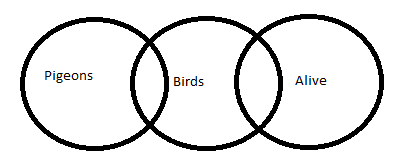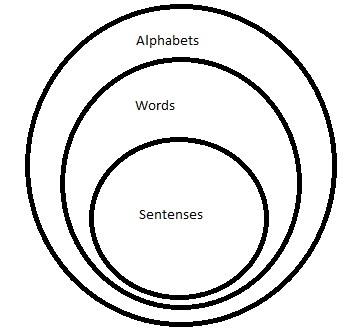Validity-of-Arguments
Question 1 |
If some pens are pencils but no pencil is sharpener then
A) All pencils are pens
B) Some sharpeners are pencils
C) Some pens are not sharpener
D) Some pencils are not pens
Choose the correct answer from the options given below:
A) All pencils are pens
B) Some sharpeners are pencils
C) Some pens are not sharpener
D) Some pencils are not pens
Choose the correct answer from the options given below:
(A) and (C) only
| |
(B) and (C) only
| |
(A) and (D) only | |
(B) and (D) only |
Question 1 Explanation:

→ All pencils are pens and Some pens are not sharpener
Note: Statement-B is definitely FALSE. So, Option-B and D are definitely wrong.
No pencil is sharpener
Then
some sharpeners are pencils ==> it is false
So we can eliminate Options consists of statement-B
Now answer is either A & C or A &D But most suitable is A &C
Question 2 |
Refer the statement and solve the question according to the conclusions.
Statement:
Some Pigeons are Bird;
Some Birds are Alive
Conclusion:
(I) Some Pigeons are Alive
(II) Some Birds are Pigeons
Only (I) follows | |
Only (II) follows | |
Both (I) & (II) follows | |
None follows |
Question 2 Explanation:

Question 3 |
Directions for question number 13 to 15:
Relationship between different elements is provided in the statements. The statements are followed by conclusions. Study the conclusions based on the given statement and choose the correct answer.
Q13: T >= U = V <= W < X; V >= Y
Conclusions:
(I) Y <= T
(II) U >= X
if only conclusion (I) follows | |
if only conclusion (II) follows | |
if neither (I) nor (II) conclusion follows | |
if both (I) and (II) conclusions follow |
Question 3 Explanation:
T >= U = V <= W < X; V >= Y
T>= U= V>= Y
Y <= T
T>= U= V>= Y
Y <= T
Question 4 |
Directions for question number 13 to 15:
Relationship between different elements is provided in the statements. The statements are followed by conclusions. Study the conclusions based on the given statement and choose the correct answer.
Q13: T >= U = V <= W < X; V >= Y
Q14. P <= Q <= R > S; T >= R; S >= U
Conclusions:
(I) T > S
(II) U < R
if only conclusion (I) follows | |
if only conclusion (II) follows | |
if neither (I) nor (II) conclusion follows | |
if both (I) and (II) conclusions follow |
Question 4 Explanation:
P <= Q <= R > S; T >= R; S >= U
T >= R > S R > S>=U
T>S U
T >= R > S R > S>=U
T>S U
Question 5 |
Directions for question number 13 to 15:
Relationship between different elements is provided in the statements. The statements are followed by conclusions. Study the conclusions based on the given statement and choose the correct answer.
Q13: T >= U = V <= W < X; V >= Y
Q15: A <= B < C >= D; C <= E <= F
Conclusions:
(I) F >= D
(II) A > E
if only conclusion (I) follows | |
if only conclusion (II) follows | |
if neither (I) nor (II) conclusion follows | |
if both (I) and (II) conclusions follow |
Question 5 Explanation:
A <= B < C >= D; C <= E <= F
D <= C <= E < F
F >= D
Question 6 |
Directions for question number 30 to 31:
Two statements followed by four conclusions numbered from (I) to (IV) are given. You have to take the two statements to be true even if these seem to be at variance from the commonly known facts. Read all the conclusions and decide which of the given conclusions logically follow from the two given statements disregarding commonly known facts.
Q30. All Shoes are Socks
Some Socks are Gloves
Conclusions:
(I) Some Shoes are Gloves
(II) Some Socks are Shoes
(III) All Gloves are Shoes
(IV) No Shoes are Gloves
Only (I) follows | |
Only (II) follows | |
Only (III) follows
| |
Only (IV) follows |
Question 6 Explanation:

Question 7 |
Directions for question number 30 to 31:
Two statements followed by four conclusions numbered from (I) to (IV) are given. You have to take the two statements to be true even if these seem to be at variance from the commonly known facts. Read all the conclusions and decide which of the given conclusions logically follow from the two given statements disregarding commonly known facts.
Q31: All Sentences are Words
All Words are Alphabets
Conclusions:
(I) All words are sentences
(II) All sentences are alphabets
(III) All alphabets are words
(IV) Some alphabets are words
Only (I) and (III) follows | |
Only (II), (III) and (IV) follows | |
Only (II) and (IV) follows | |
All follows |
Question 7 Explanation:

Question 8 |
All Boys are Girls
No Girl is a Man
Conclusions:
(I) No Boy is a Man
(II) Some Boys are Man
(III) All Girls are Boys
(IV) Some Man are Boys
Only (III) follows | |
Only (I) follows | |
All follows | |
None follows
|
Question 8 Explanation:

Question 9 |
"If I were, a heavy smoker, smoking would shorten my life. That's why I do not smoke. And I except to live a long and healthy life". Which fallacy is committed in the above argument?
Existential fallacy | |
Undistributed middle | |
Affirming the consequent | |
Denying the antecedent |
There are 9 questions to complete.
